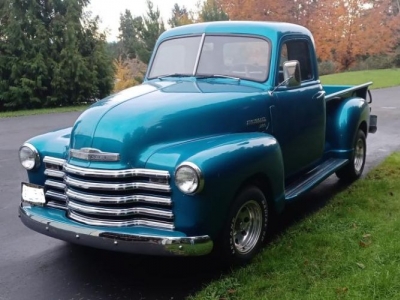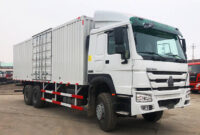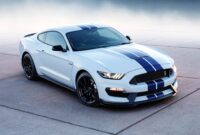1949 Chevy Trucks For Sale: Your Comprehensive Guide to Acquiring an American Icon pickup.truckstrend.com
The year 1949 holds a special place in automotive history, particularly for truck enthusiasts. It was a time when America was emerging from the shadows of war, and General Motors responded to the nation’s demand for practical, yet stylish, vehicles with its groundbreaking Advance-Design series. Among these, the 1949 Chevy truck stands out as an enduring symbol of post-war optimism, American resilience, and timeless design. More than just a utility vehicle, it has evolved into a highly sought-after classic, prized by collectors, restorers, and hot-rodders alike.
For anyone considering a foray into the world of classic vehicles, a 1949 Chevy truck for sale represents not just a purchase, but an investment in a piece of rolling history. Its rugged simplicity, iconic good looks, and surprising versatility make it a popular choice for restoration projects, custom builds, or simply as a weekend cruiser. This comprehensive guide will navigate you through everything you need to know about finding, evaluating, and acquiring your very own 1949 Chevy truck.
1949 Chevy Trucks For Sale: Your Comprehensive Guide to Acquiring an American Icon
The Enduring Appeal of the 1949 Chevy Truck
What is it about the 1949 Chevy truck that continues to captivate generations? Part of its allure lies in its design. The Advance-Design series, introduced in 1947, was a radical departure from the pre-war "Art Deco" styling. It featured a wider, lower, and more streamlined cab, integrated headlights, and a five-bar horizontal grille that became instantly recognizable. The 1949 model year, while not significantly different from 1947 or 1948, perfected these aesthetics with minor tweaks, solidifying its place as a classic.
Beyond aesthetics, these trucks were built to last. Their robust frames, simple inline-six engines (typically the 216 cubic inch "Thriftmaster"), and durable transmissions made them workhorses for farms, businesses, and families across America. This inherent toughness means many examples have survived to this day, making them excellent candidates for restoration or modification. The extensive availability of aftermarket parts, coupled with their relatively straightforward mechanicals, further enhances their appeal, making them accessible projects even for hobbyists. Owning a 1949 Chevy truck is not just about driving; it’s about connecting with a bygone era, a piece of Americana that continues to resonate.
Types of 1949 Chevy Trucks You Might Find
When searching for a 1949 Chevy truck for sale, you’ll encounter a variety of body styles and conditions. Understanding these can help narrow your search:
- 3100 Series (Half-Ton Pickup): This is by far the most common and sought-after model. It’s the quintessential pickup truck, perfect for cruising or light hauling. Most of the trucks you see restored or customized will be 3100s.
- 3600 Series (Three-Quarter-Ton Pickup): Slightly larger and more robust than the 3100, featuring a longer bed and heavier-duty suspension. Less common but still popular for those needing a bit more utility.
- 3800 Series (One-Ton Pickup/Chassis Cab): The heaviest-duty pickup, often found as a chassis cab with custom beds (stake beds, flatbeds) or as a panel truck. These are less common as pickups but highly valued in their specialized forms.
- Panel Trucks: These enclosed delivery vehicles offer significant cargo space and a unique, nostalgic aesthetic. They are often converted into custom campers, mobile businesses, or unique street rods.
- Suburban Carryall: The ancestor of the modern SUV, the 1949 Suburban is a true rarity. Featuring multiple rows of seating and windows, these are highly collectible and command premium prices.
- School Buses/Large Chassis: While less common for personal restoration, the Advance-Design chassis was also used for larger applications.


Beyond body style, trucks are typically categorized by their current state:
- Project Trucks: Often non-running, rusty, and incomplete. These require significant time, money, and expertise but offer the lowest entry price.
- Driver Quality: Running and driving, but likely needs cosmetic work, mechanical refreshing, or minor repairs. Good for those who want to enjoy the truck immediately.
- Restored/Good Condition: Trucks that have undergone a full or partial restoration, preserving their original appearance. Prices vary based on the quality of the restoration.
- Restomod/Custom: Featuring modern powertrains (V8 engine swaps), updated suspensions, power steering/brakes, and custom interiors. These offer classic looks with modern drivability and command the highest prices.
- Rat Rods: Intentionally left with a weathered, "unfinished" look, often with modern mechanicals underneath. A specific aesthetic choice.

Where to Find 1949 Chevy Trucks For Sale
The digital age has made finding classic vehicles significantly easier. Here are the primary avenues for your search:
- Online Marketplaces:
- ClassicCars.com, Hemmings.com: Premier sites for classic vehicle listings, offering a wide range of conditions and prices from reputable dealers and private sellers.
- eBay Motors: A vast marketplace where you can find anything from rusty projects to fully restored examples. Be diligent with inspections.
- Bring a Trailer (BaT): An auction site known for high-quality, well-documented vehicles. Prices can be competitive, and the transparency is excellent.
- Specialty Forums & Social Media Groups: Many Facebook groups and dedicated online forums exist for Advance-Design Chevy truck enthusiasts. These are great places to find trucks directly from owners and get advice.
- Classic Car Dealerships: Many dealerships specialize in vintage trucks. They often offer pre-inspected vehicles and may provide warranties or financing options.
- Auctions: Major auction houses like Mecum, Barrett-Jackson, and RM Sotheby’s frequently feature high-end restored or custom 1949 Chevy trucks. Smaller local auctions can also yield finds.
- Local Classifieds & Word-of-Mouth: Don’t underestimate the power of local listings (Craigslist, local papers) or simply asking around. Barn finds still happen!
What to Look For: A Buyer’s Checklist
Acquiring a classic truck requires a keen eye and thorough inspection. Here’s a checklist of critical areas:
- Rust: The biggest enemy of any vintage vehicle. Inspect thoroughly:
- Cab: Cab corners, floor pans (especially under the mat), kick panels, door bottoms, roof seams.
- Fenders: Inner and outer wheel wells, lower sections.
- Bed: Bed floor, bed sides, stake pockets, tailgate.
- Frame: Check for cracks, bends, or severe pitting, especially around suspension mounting points.
- Body Panels & Alignment: Look for consistent gaps between doors, fenders, and hood. Uneven gaps can indicate past accidents or poor bodywork. Check for excessive body filler (bondo) by tapping panels; a dull thud often means filler.
- Engine & Drivetrain:
- Original 216/235 Inline-Six: Check for leaks, strange noises, smoke from the exhaust, and overall running condition. Are all accessories present?
- Modern Swaps: If it has a V8 or other modern engine, ensure the swap was done professionally. Check wiring, cooling, and exhaust. Test drive to check transmission shifts.
- Chassis & Suspension: Inspect leaf springs, shocks, kingpins, and tie rod ends. Look for excessive play in the steering. Check brake lines for corrosion or leaks (especially for drum brakes).
- Interior: Assess the condition of the seat upholstery, headliner, door panels, and dash. Are gauges functional? Is the wiring messy or appears professionally done?
- Electrical System: Original wiring can be brittle and problematic. Look for frayed wires, bare connections, or obvious splices. A new wiring harness is a common and worthwhile upgrade. Test all lights, horn, and wipers.
- Documentation: Always verify the VIN (Vehicle Identification Number) on the title matches the one on the truck (typically on the driver’s side door jamb or frame rail). Ask for any maintenance records, build sheets, or previous ownership history.
Practical Advice:
- Bring a Magnet: Use a small magnet to detect areas filled with body filler (it won’t stick to bondo).
- Hire a Pre-Purchase Inspector: For significant purchases, especially if you’re not mechanically inclined or buying long-distance, a professional inspection is invaluable.
- Ask Questions: Don’t be afraid to ask the seller about the truck’s history, any known issues, and why they are selling.
- Set a Realistic Budget: Beyond the purchase price, factor in potential restoration costs, insurance, and ongoing maintenance.
Understanding Valuation and Pricing
The price of a 1949 Chevy truck for sale can vary dramatically, from a few thousand dollars for a true project to well over $100,000 for a concourse-quality restoration or a highly customized restomod. Several factors influence value:
- Condition: This is the primary driver. A non-running rusty shell is worth significantly less than a perfectly restored example.
- Originality vs. Modification: Highly original, well-preserved trucks can command a premium from purists. Meanwhile, professionally built restomods with modern amenities also fetch high prices due to the significant investment in parts and labor.
- Rarity of Body Style: Panel trucks and especially Suburbans are rarer than 3100 pickups and often command higher prices for comparable condition.
- Quality of Restoration/Work: A shoddy paint job or poor mechanical work will decrease value. High-quality craftsmanship increases it.
- Documentation: A well-documented history can add value and peace of mind.
- Location: Prices can fluctuate based on regional markets.
Here’s an approximate price guide for 1949 Chevy Trucks (3100 Series Pickup, as of late 2023/early 2024), but remember these are estimates and can vary widely:
1949 Chevy Truck Estimated Price Guide (3100 Series Pickup)
| Condition Category | Description | Estimated Price Range (USD) |
|---|---|---|
| Project Truck | Non-running, significant rust, incomplete, requires full restoration. | $3,000 – $8,000 |
| Driver Quality | Runs and drives, functional, but needs cosmetic work, minor mechanical repairs, or interior refreshing. | $8,000 – $25,000 |
| Good Restored | Solid, mostly original or period-correct components, good paint and interior, reliable driver. | $25,000 – $45,000 |
| Show Quality/Restomod | Meticulously restored to original specifications OR professionally customized with modern upgrades. | $45,000 – $100,000+ |
Disclaimer: Prices are highly variable based on specific features, engine type, documentation, geographic location, and market demand.
Post-Purchase Considerations
Once you’ve found your perfect 1949 Chevy truck for sale and closed the deal, the journey continues:
- Insurance: Standard auto insurance policies may not adequately cover classic vehicles. Look into specialized classic car insurance, which often offers agreed-upon value coverage and lower premiums for limited mileage.
- Maintenance: Even a fully restored truck will require regular maintenance. Parts availability for Advance-Design trucks is excellent, with numerous aftermarket suppliers. Consider finding a mechanic experienced with vintage vehicles or be prepared to learn to do some work yourself.
- Customization/Restoration: If you bought a project, plan your restoration carefully. Decide whether you want to preserve originality or build a custom truck. Budget accordingly, as costs can quickly escalate.
- Driving Experience: Remember that a 1949 truck drives differently than a modern vehicle. Expect manual steering, drum brakes (with longer stopping distances), and a less refined ride. Modifications like power steering, power brakes (disc brake conversions), and updated suspensions can greatly improve drivability.
Concluding Summary
The quest for a 1949 Chevy truck for sale is an exciting journey into the heart of American automotive history. These iconic vehicles offer a unique blend of rugged charm, timeless design, and a connection to a bygone era. Whether you’re seeking a challenging restoration project, a reliable driver, or a show-stopping custom, the market offers a wide array of options. By understanding the different types, knowing where to look, conducting thorough inspections, and appreciating the factors that influence value, you can confidently navigate the buying process. Acquiring a 1949 Chevy truck is more than just buying a vehicle; it’s investing in a piece of Americana, a conversation starter, and a source of immense pride and enjoyment for years to come.
Frequently Asked Questions (FAQ) about 1949 Chevy Trucks For Sale
Q1: Are parts for 1949 Chevy trucks readily available?
A1: Yes, absolutely! The Advance-Design series (1947-1955) was produced in vast numbers, and there is an excellent aftermarket industry dedicated to these trucks. You can find almost any part, from body panels and trim to engine components and interior pieces, through various online suppliers and classic truck specialists.
Q2: Are 1949 Chevy trucks easy to work on for a beginner?
A2: Relatively speaking, yes. Their mechanical systems are much simpler than modern vehicles, lacking complex electronics. The inline-six engine is robust and straightforward. Many basic maintenance and repair tasks are accessible to a novice with a good shop manual and some patience. However, bodywork and extensive frame repair require more specialized skills.
Q3: What kind of fuel economy can I expect from an original 1949 Chevy truck?
A3: Fuel economy is not a strong suit of these vintage trucks. With their original 216 or 235 cubic inch inline-six engines and carbureted fuel systems, you can typically expect mileage in the range of 10-15 miles per gallon, depending on driving conditions and maintenance. Modern engine swaps (e.g., V8s with fuel injection) can improve efficiency.
Q4: Can a 1949 Chevy truck be a reliable daily driver?
A4: An original 1949 Chevy truck can be driven daily, but it requires a different mindset. They lack modern comforts like power steering, power brakes, and air conditioning. For true daily driving, many owners opt for "restomod" conversions, which involve upgrading to a modern engine, transmission, disc brakes, power steering, and better suspension for improved safety, comfort, and reliability.
Q5: What’s the main difference between a 1947, 1948, and 1949 Chevy truck?
A5: The 1947-1955 Advance-Design series saw relatively minor changes year-to-year. For 1947-1949, the differences are subtle. The 1947 and early 1948 models had vent windows integrated into the main window glass. Later 1948 and all 1949 models introduced separate vent windows. Other changes were mostly trim-related. The core design remained largely consistent until the "Task Force" redesign in 1955.
Q6: Are 1949 Chevy trucks a good investment?
A6: For well-maintained, properly restored, or high-quality custom examples, 1949 Chevy trucks have generally held their value well and, in many cases, appreciated over time. Like any classic vehicle, the best investments are those in excellent condition or those with professional, desirable modifications. Project trucks are an investment of time and money, with the potential for appreciation upon completion.



